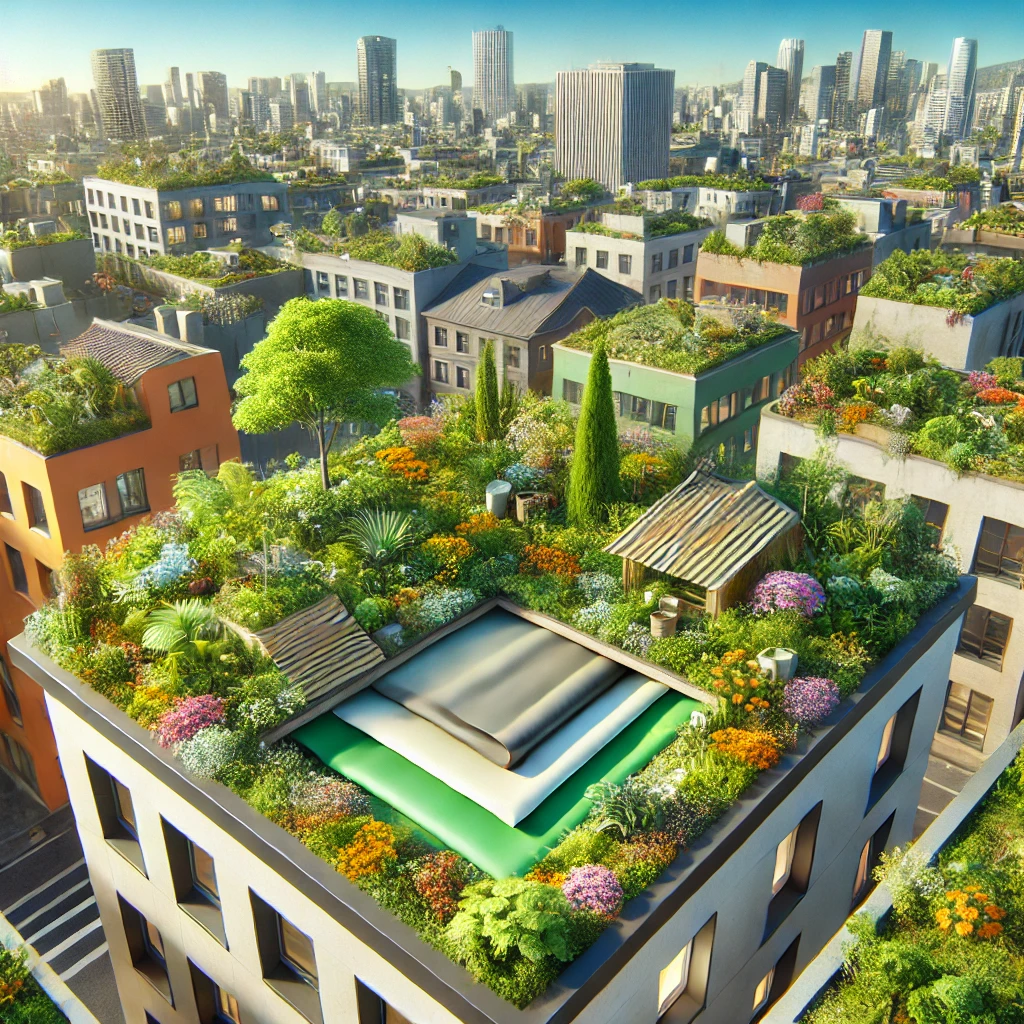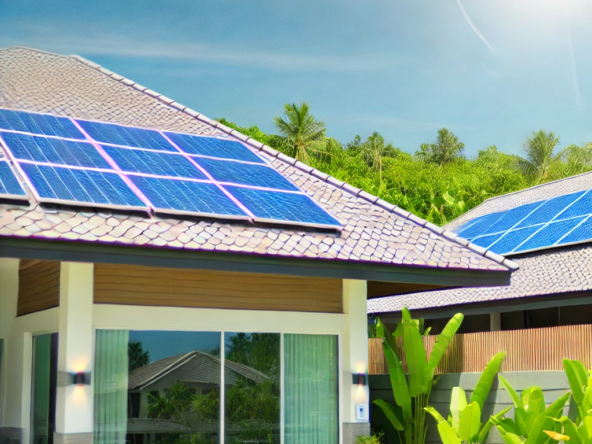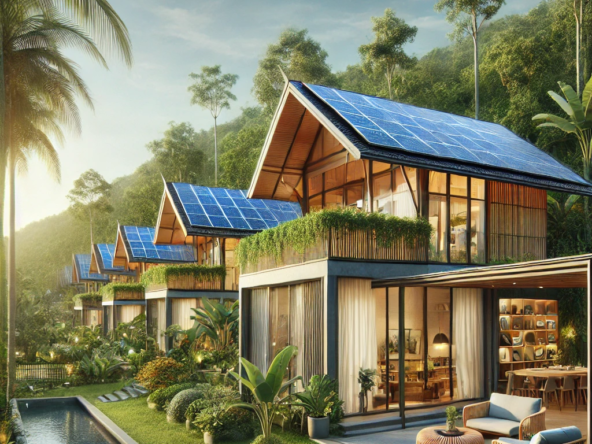As our cities continue to grow, integrating nature into urban spaces has become a vital aspect of sustainable development. Green roofs and urban gardens not only beautify concrete landscapes but also offer a range of environmental, economic, and social benefits. From reducing urban heat to enhancing mental well-being, green roofs and urban gardens play a crucial role in creating resilient, eco-friendly cities. This guide delves into the types, benefits, and steps for creating green roofs and urban gardens, with practical advice for getting started in your own community.
1. What are Green Roofs and Urban Gardens?
A green roof is a layer of vegetation planted over a waterproofing system on top of a building. These roofs can be extensive (low-maintenance, lightweight plants) or intensive (deeper soil, larger plants, higher maintenance). Urban gardens, on the other hand, transform unused city spaces—like vacant lots, rooftops, or balconies—into productive green areas where residents can grow flowers, plants, or even fresh produce. Both green roofs and urban gardens contribute to sustainable urban development and are increasingly popular in cities worldwide.
2. Types of Green Roofs
Understanding the various types of green roofs helps you select the one best suited to your space and goals.
- Extensive Green Roofs: These lightweight roofs use shallow soil (2-6 inches), making them ideal for low-maintenance plants like sedums, mosses, and grasses. Extensive roofs are often used in residential settings and require minimal upkeep.
- Intensive Green Roofs: With deeper soil (6+ inches), these roofs support a variety of vegetation, from shrubs to small trees, and can even include pathways for walking. While they offer more biodiversity, intensive green roofs are heavier and require significant structural support, irrigation, and maintenance.
- Semi-Intensive Green Roofs: A hybrid option, these roofs combine elements of both extensive and intensive roofs, allowing for more diverse planting without the structural demands of a fully intensive green roof.
3. Benefits of Green Roofs and Urban Gardens
Both green roofs and urban gardens deliver a range of benefits that extend beyond aesthetics. Let’s explore how they make cities healthier, economically viable, and more sustainable.
Environmental Benefits
- Reduces Urban Heat: Green roofs and urban gardens act as natural insulators, reducing rooftop temperatures by up to 30°F (16°C). This cooling effect helps counteract the urban heat island phenomenon, which is especially valuable in dense, built-up areas.
- Improves Air Quality: Plants naturally filter pollutants from the air, capturing particulates and producing oxygen. Studies show that green roofs can reduce sulfur dioxide and other airborne pollutants, directly improving urban air quality.
- Stormwater Management: Vegetated roofs and gardens absorb significant amounts of rainwater, helping reduce stormwater runoff and relieving stress on city drainage systems. Intensive green roofs can retain up to 70-90% of rainwater in the summer and 25-40% in winter.
Economic Benefits
- Energy Savings: By insulating buildings, green roofs can reduce energy costs associated with heating and cooling by up to 30%, depending on the climate and building type.
- Increases Property Value: Green infrastructure like green roofs and urban gardens can increase property value by making buildings more attractive to buyers, renters, and investors. Studies suggest that properties with green roofs or urban gardens may experience a 10-15% increase in market value.
- Tax and Incentive Programs: Many cities offer tax incentives, grants, and rebates for green roof installations and urban gardens, reducing the initial investment costs. Check local policies to see what support is available in your area.
Social and Health Benefits
- Enhances Mental Health: Access to green spaces has been shown to reduce stress, improve mood, and even alleviate symptoms of anxiety and depression. For city dwellers, green roofs and urban gardens provide much-needed natural spaces for relaxation.
- Fosters Community: Urban gardens, especially community gardens, create spaces where people can connect, share gardening tips, and work together. These interactions build a sense of community and belonging, fostering social ties.
- Promotes Food Security: Urban gardens, whether in community plots or on rooftops, can produce fresh fruits and vegetables for local residents. This reduces food miles, cuts down on grocery expenses, and promotes access to nutritious produce.
4. Step-by-Step Guide to Starting a Green Roof or Urban Garden
If you’re inspired to create your own green roof or urban garden, here’s a practical step-by-step guide to help you get started.
For Green Roofs
- Consult with a Structural Engineer: Before installing a green roof, ensure your building can support the weight. This is crucial, especially for intensive roofs.
- Choose the Right Type of Green Roof: Based on your goals and building structure, decide between extensive, intensive, or semi-intensive. An extensive roof may be better for residential homes, while intensive roofs suit commercial buildings with recreational areas.
- Set Up Drainage and Irrigation Systems: Green roofs need proper drainage to prevent water buildup and damage to the roof. Consider installing a lightweight, efficient irrigation system, especially if you choose plants that require regular watering.
- Select Native Vegetation: Opt for plants suited to your climate and rainfall levels. Hardy, drought-tolerant species can help reduce maintenance and water usage.
- Plan for Regular Maintenance: Even extensive green roofs benefit from annual maintenance to check plant health and inspect drainage systems. Intensive roofs will require more frequent attention.
For Urban Gardens
- Choose the Right Location: Find a spot with adequate sunlight and access to water. For rooftop gardens, ensure the structure can support the weight.
- Prepare Soil and Compost: Use nutrient-rich soil and consider composting kitchen scraps to create natural fertilizer. Good soil is essential for plant health.
- Start Small: Begin with easy-to-grow plants like herbs, leafy greens, and tomatoes. Once you gain experience, expand to other plants.
- Engage the Community: If starting a community garden, reach out to neighbors or community members to share responsibilities, funding, and produce.
- Monitor and Harvest Regularly: Maintain your garden by watering, weeding, and harvesting produce. Regular monitoring will keep plants healthy and productive.
5. Inspiring Case Studies and Real-Life Examples
Here are some successful implementations of green roofs and urban gardens that showcase the potential of these green spaces in urban settings:
- Chicago City Hall: Covering 20,000 square feet, the green roof on Chicago’s City Hall was installed to combat the city’s urban heat. The project has not only reduced cooling costs but also inspired similar initiatives across the city.
- Brooklyn Grange Farm (New York City): Operating one of the largest rooftop farms in the world, Brooklyn Grange produces over 50,000 pounds of organic produce each year. This rooftop farm has become a model for urban agriculture and offers educational programs and community events.
- Pasona Urban Farm (Tokyo): Tokyo’s Pasona Group transformed its headquarters into an urban farm, growing rice, tomatoes, and herbs indoors. This green space improves employee morale and demonstrates innovative, sustainable agricultural practices.
6. Addressing Common Challenges
While green roofs and urban gardens offer a wealth of benefits, there are some challenges to consider:
- Cost and Maintenance: Initial installation for green roofs can be expensive, and they require regular maintenance. However, many cities offer incentives, and costs can be offset by reduced energy expenses.
- Climate Considerations: In areas with extreme weather, plants may need extra insulation or irrigation. Choose plants that are suited to your climate, such as drought-resistant varieties for arid locations.
- Space Limitations: For urban gardens in small spaces, try vertical gardening, container gardening, or compact plant varieties. These methods maximize limited space and allow even small areas to flourish.
7. DIY Urban Gardens: Options for Every Budget
If you don’t have access to a large rooftop or community plot, there are still ways to start a garden with limited space and resources:
- Balcony or Window Box Gardens: Small, container-based gardens are perfect for city dwellers with limited outdoor space. Herbs, flowers, and salad greens thrive in small pots and add a touch of nature to any space.
- Vertical Gardens: Using wall-mounted containers or repurposed pallets, you can create a vertical garden that takes up minimal floor space.
- Community Partnerships: Reach out to local organizations or community groups to find support for starting or maintaining a garden, which can help with funding and share the maintenance load.
8. Green Roofs and Urban Gardens: A Step Toward Sustainable Cities
As cities strive to balance growth with sustainability, green roofs and urban gardens offer a tangible solution that benefits residents and the environment alike. They cool urban areas, provide fresh food, improve mental well-being, and foster community connections. By embracing green infrastructure, we can transform our cities into greener, healthier, and more resilient places to live.
Whether you’re looking to start a green roof or simply grow some herbs on your balcony, every effort counts. Explore options, get involved in local initiatives, and contribute to a sustainable urban future—one green space at a time.
9. Getting Involved and Expanding Green Spaces in Your Community
Green roofs and urban gardens can be catalysts for broader urban green space initiatives. If you’re passionate about sustainability and interested in expanding green spaces in your community, here are some steps to take your involvement further:
Join or Start a Community Garden
- Look for existing community gardens in your area through local government or community websites. Many gardens welcome volunteers and are open to new members.
- If your community lacks a green space, gather a group of interested neighbors and reach out to your city council or local nonprofits. Many cities offer grants or support for community-based green space projects, and pooling resources with others can make the project more feasible.
Advocate for Green Infrastructure Policies
- Get involved in local government meetings or sustainability initiatives. Advocate for policies that support green roofs, urban gardens, and other green infrastructure. Many cities offer tax incentives, grants, and support to buildings that implement green roofs.
- Support organizations or advocacy groups that focus on urban greening projects, like the Sustainable Sites Initiative or Green Roofs for Healthy Cities.
Educate and Inspire Others
- Organize educational workshops or talks on urban gardening, green roofs, or sustainability. Schools, community centers, or neighborhood associations are often open to hosting events that encourage residents to get involved.
- Use social media to share your experiences, photos, and tips. Highlight the benefits of green roofs and urban gardens, and document the transformation of urban spaces. Sharing success stories online can inspire others in your community to start similar projects.
Volunteer with Urban Agriculture Programs
- Many urban areas have organizations dedicated to urban agriculture, rooftop farming, and community gardening. Volunteer opportunities range from helping with planting and maintenance to organizing community events and educational programs.
- These organizations are often connected to food justice initiatives, providing fresh produce to underserved communities, so your involvement can contribute to greater social equity in your city.
10. Long-Term Care and Maintenance Tips
For green roofs and urban gardens to thrive, regular care and maintenance are essential. Here are tips for ensuring long-term success:
- Seasonal Inspections: Schedule seasonal inspections to monitor plant health, check drainage systems, and inspect waterproofing materials. For intensive green roofs, annual maintenance is crucial to manage weight load and vegetation growth.
- Efficient Irrigation: Install drip irrigation or self-watering systems to conserve water and ensure consistent hydration. Water needs vary with the seasons, so adjust irrigation schedules accordingly.
- Pest Control: To keep pests at bay, opt for organic methods like introducing beneficial insects or using natural repellents. Encourage biodiversity by incorporating a variety of plants that attract pollinators and deter harmful pests.
- Soil and Compost Management: Regularly replenish nutrients by adding compost or organic fertilizers, particularly for urban gardens growing food. Healthy soil is the foundation of a thriving green space and supports plant resilience.
- Adapt to Climate Changes: Urban climates can fluctuate, with extreme temperatures, droughts, or heavy rainfall. Be prepared to adjust your plant choices and watering schedule, and consider investing in drought-resistant species for regions prone to dry spells.
11. Resources for Green Roof and Urban Garden Enthusiasts
Whether you’re a beginner or seasoned green enthusiast, here are some resources to help you along your journey:
- Local Government Green Roof Incentive Programs: Many cities provide tax credits, rebates, and grants to promote green roofs. Research local incentives that can help offset initial costs.
- Green Roof Organizations: Groups like Green Roofs for Healthy Cities and the International Green Roof Association offer educational resources, certification programs, and access to industry experts.
- Urban Agriculture Networks: Websites like Urban Agriculture Network or American Community Gardening Association offer resources, directories, and support for urban gardeners.
- DIY Gardening Apps: Apps like PlantSnap, Gardenia, or iNaturalist can help identify plants, offer care advice, and connect you with other urban gardeners.
- Educational Workshops and Webinars: Look for online workshops and webinars hosted by environmental organizations and local horticultural societies. Topics range from plant selection and maintenance to building small-scale green roofs.
12. Conclusion: Embracing Green Roofs and Urban Gardens for a Sustainable Future
Green roofs and urban gardens represent a shift towards sustainable urban design, helping cities meet the demands of population growth while enhancing quality of life. By cooling cities, improving air quality, providing food, and fostering community, these green spaces address some of the most pressing challenges of urbanization.
Implementing a green roof or urban garden may seem like a small step, but collectively, these projects have the potential to transform entire neighborhoods and cities. From individuals planting herbs on their balcony to large-scale green roofs on skyscrapers, every green space contributes to a healthier, more resilient urban environment.
If you’re ready to join the movement, start exploring green space options in your community, get involved in local initiatives, and take steps to create your own green haven. Together, we can create a greener, more sustainable world—one roof and garden at a time.



